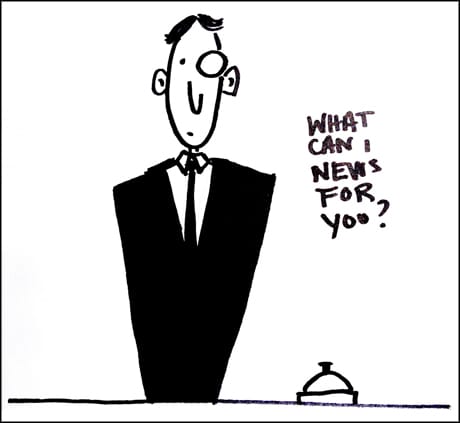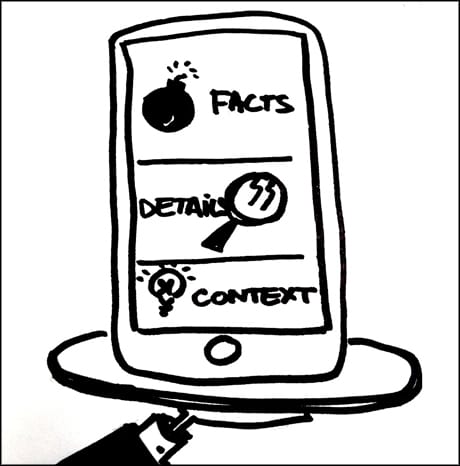News on Demand to offer articles based on readers' attention
With so many competing choices for readers' attention, a new project funded by the Knight Foundation hopes to give readers more choice over story length and detail


With so many competing choices for readers' attention, a new project funded by the Knight Foundation hopes to give readers more choice over story length and detail

This article was migrated from an old version of our website in 2025. As a result, it might have some low-quality images or non-functioning links - if there's any issues you'd like to see fixed, get in touch with us at info@journalism.co.uk.
Round-the-clock news and the rising prevalence of smartphones put increasing demands on our attention from media sources, let alone the day-to-day necessities of work, family and travel. Eating and sleeping should be in there somewhere. And some time to relax would be nice too.
Based on these competing demands for time, a new project funded by the Knight Foundation hopes to provide curated news to readers through a mobile app, allowing them to quickly choose stories based on how much time they have available and what stories they feel they need to read to be informed.
"Are you in a hurry? Are you busy? Are you on a break? These are defining and different spans of attention that you can dedicate to content," Marie-Catherine Beuth, a Knight Fellow at Stanford University and the brains behind attention-centric project News on Demand , told Journalism.co.uk.
"If you're really in a hurry maybe you just want to see what the main story is today, or what are the three most important headlines."
Rather than give users one long article on a topic, the app will present the five main news stories of the day as different lengths of article, curated from reputable news sources.
Readers will be able to choose a story that interests them and the length of story they have time to read.
"I don't want to create new media or create a new layer of content," Beuth continued. "There is a lot of great content out there in many shapes, many forms that fit different types of attention profiles, so my goal is really not to have editors create summaries."

Screenshot from Newstap.es
Instead she intends to build on her work at Newstapes , the site she founded to act as a 'news concierge', by collecting the main stories of the day and delivering the articles that explain the topics best at different lengths.
News on Demand is based on a concept Beuth has been working on for some time at Stanford University in personalising the delivery of news around a reader's time, level of attention and desire to read certain stories.
If you put a reader or user in touch with a really great story then people don't let themselves be interrupted, and this is where the magic happens - Marie-Catherine Beuth, News on Demand
The volume of choices and information available to every reader now means the "pool of competitors in the news industry" is much larger, she said, so "media outlets should try to think how they can make the best use of the time people spend with [them]".
While apps like Circa provide single updates on news stories, the new trend in explanatory journalism is at the opposite end of the spectrum. Where one provides small updates, the other seeks to cover a inform the reader in a deeper sense, but Beuth hopes to see if it is possible to do both by giving the reader simple choices based on what they want.
"If you're European you may be more interested in what's going on in Ukraine than if you're American," she said, "where you're more interested in a local politics story.
"So you have to balance that out if you promise to tailor content around time. Maybe five minutes on Ukraine will not be a long time for me but it will be way too long for somebody else."

Screenshot from Newstap.es
Over the next six months, Beuth will be developing the app alongside web engineer Xavier Laumonier , finding a way to curate stories on a larger scale and fine-tuning how News on Demand will best deliver the stories people want to read, in the way they want to read them. The pair are still looking for a graphic designer to help with the user experience and user interface.
"The ideal scenario would be, as we design and test this prototype, we will learn great things and figure out that we are on the right track," she said.
"The six months will be a launch pad for making this bigger and more efficient and move from something that is very much human-based curation into a more hybrid model. But maybe along the way we will find out that this is not the right way to go."
The main challenge though, for News on Demand and the industry on the whole, is in overcoming the air of "permanent interruptibility" attached to the smartphone, she said.
"If you put a reader or user in touch with a really great story then people don't let themselves be interrupted, and this is where the magic happens.
"There are still a lot of stories where you surprise yourself and get completely drawn and fascinated and not interrupted, and I want to figure out a way to do that more often rather than 'oh, for once I read a story where I didn't want to check my Facebook'."